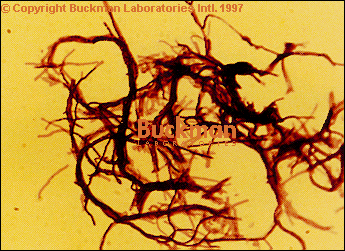|
Actinomycetes are a heterogenic group of very diverse gram-positive bacteria They are usually found in a filamentous form, with a branching growth pattern that results in an extensive colony. Some of these colonies, or mycelium, can stretch out through acres of soil. Some types of colonies may break apart to form rod shaped forms. Other types form spores. Actinomycetes are the source of over ten-thousand-compounds, and are a valuable source of enzymes and vitamins.
Actinomycetes occur in most soils, usually in the top six to twelve inches, where most of the materials that support their life exists. They are an essential part of plant growth as part of the soil community of microorganisms. This soil micro-society is reliant upon a balance of the species. While Actinomycetes are not the most abundant of the five major groups of microorganisms, their presence is essential, as they are the primary decomposers of tough plant tissue residues such as tree bark, plant stems, and wood pulp type materials. They are effective in the softening and breakdown of other tough materials like to twelve inches, where most of the materials that support their life exists. They are an essential part of plant growth as part of the soil community of microorganisms. This soil micro-society is reliant upon a balance of the species. While Actinomycetes are not the most abundant of the five major groups of microorganisms, their presence is essential, as they are the primary decomposers of tough plant tissue residues such as tree bark, plant stems, and wood pulp type materials. They are effective in the softening and breakdown of other tough materials like
|
Actinomycetes Buckman Laboratories 1997
|
cellulose, chitin, and lignin. Soil’s “earthy” smell is caused by Actinomycetes.
Most scientific authorities recognize eight groups, or genera of Actinomycetes. Most forms of soil Actinomycetes are harmless to animal and higher plant forms. Some are important pathogens. Many forms of Actinomycetes products are vital in human and animal medicine as well as agriculture. Of those species that are responsible for ailments in animals and humans, technology has been able to produce antibiotics for treatment of such infections, some of the more common being sporaricin and streptomycin and their derivatives.
As is with most bacteria, Actinomycetes have a unique ability to survive without sustainable food sources by means of their ability to go dormant for extended periods of time. Actinomycetes, as classified, have many similar characteristics as most common soil bacteria.
|


